Like it or not, it looks like we’ll be celebrating this holiday season mostly at home, shelving our plans for festive meals and parties out in favor of more cooking and eating in. Even more than usual, this means our choices about what we eat and how we prepare it matter more than ever.
Piedmont’s Climate Action Plan and yearly greenhouse gas inventories tell us that our homes and cars create the bulk of our collective emissions within the boundaries of our fair town. But you might be surprised to learn that the impact of our food choices dwarfs that of our energy usage in the grand scheme of things.
Eating “down the carbon chain,” which basically means eating less red meat and dairy, is a biggie we’ve highlighted in the past. So-called plant-rich diets pencil out as one of the biggest solutions according to Project Drawdown, a group that models the point when levels of greenhouse gases stop climbing and start to steadily decline. Even more pointed, a study this month in Science magazine concludes that we cannot possibly reach urgent climate goals, in the US or globally, without reforming how we eat and the way we farm. You can learn more and commit to making some small diet changes with a big impact as part of the Piedmont Climate Challenge.
But the real biggie? Food waste! According to multiple sources, including Drawdown, “roughly a third of the world’s food is never eaten, which means land and resources used and greenhouse gases emitted in producing it were unnecessary.” On top of that, food we discard into the trash (rather than our green compost bins) creates methane, a greenhouse gas much more potent than carbon dioxide, as it decomposes in landfills.
Stop and think about that: we don’t eat 30-40% of the food we grow, process, distribute and buy! We’ve all had the experience of finding wilted produce in our crisper and “vintage” leftovers on a forgotten shelf. But with some vigilance and motivation, it’s possible to battle food waste in our homes.
I’m a fan of using grocery delivery services (Good Eggs is my favorite) to schedule multiple deliveries per week and avoid overbuying. You can also master a few dishes like frittatas, soups, stir fries, and fried rice, that readily accept bits of leftover vegetables or meats. And definitely compost rather than trashing food scraps, but try not to let compost be an excuse to waste food, a trap many households fall into according to studies.
Reducing food waste is the single most impactful Drawdown solution, with a much bigger impact than solar or electric cars. But, when it comes to reversing climate change, we don’t have the luxury of either/or solutions. We need to eat down the food chain AND reduce food waste AND add solar, AND switch to electric cars, and do it all soon.
National Geographic how and why we waste so much food. StopWaste and the NRDC’s Save the Food campaign provide a range of practical tips and tools, like food storage reference guides and meal-planning “guestimators” that help you to buy and serve accurate quantities.
So, let’s make the most of this mostly at-home holiday season to cultivate some mostly planet-friendly food practices, and carry them with us post-pandemic, into 2021 and beyond.

We’ve decided to do a vegetarian Thanksgiving meal this year– bought a subscription to NYT Cooking and will attempt a Mushroom Wellington as our main plus family favorites like garlic mashed potatoes and pumpkin pie for sides and dessert. We’re not vegan yet but we’re exploring options for reducing dairy as well (e.g. oat milk and oat creamer, cashew ice cream) How will I replace CHEESE?! 🙂
yay for Good Eggs! Also, Imperfect produce is great. https://www.imperfectfoods.com/join?utm_source=adwords&gclid=Cj0KCQiAqdP9BRDVARIsAGSZ8AmxIaZVziT1pQ9mz-5U6gIXovdhYL5PsMy3Xr6ejqjQjZ-Y4bHZLzAaAvBvEALw_wcB